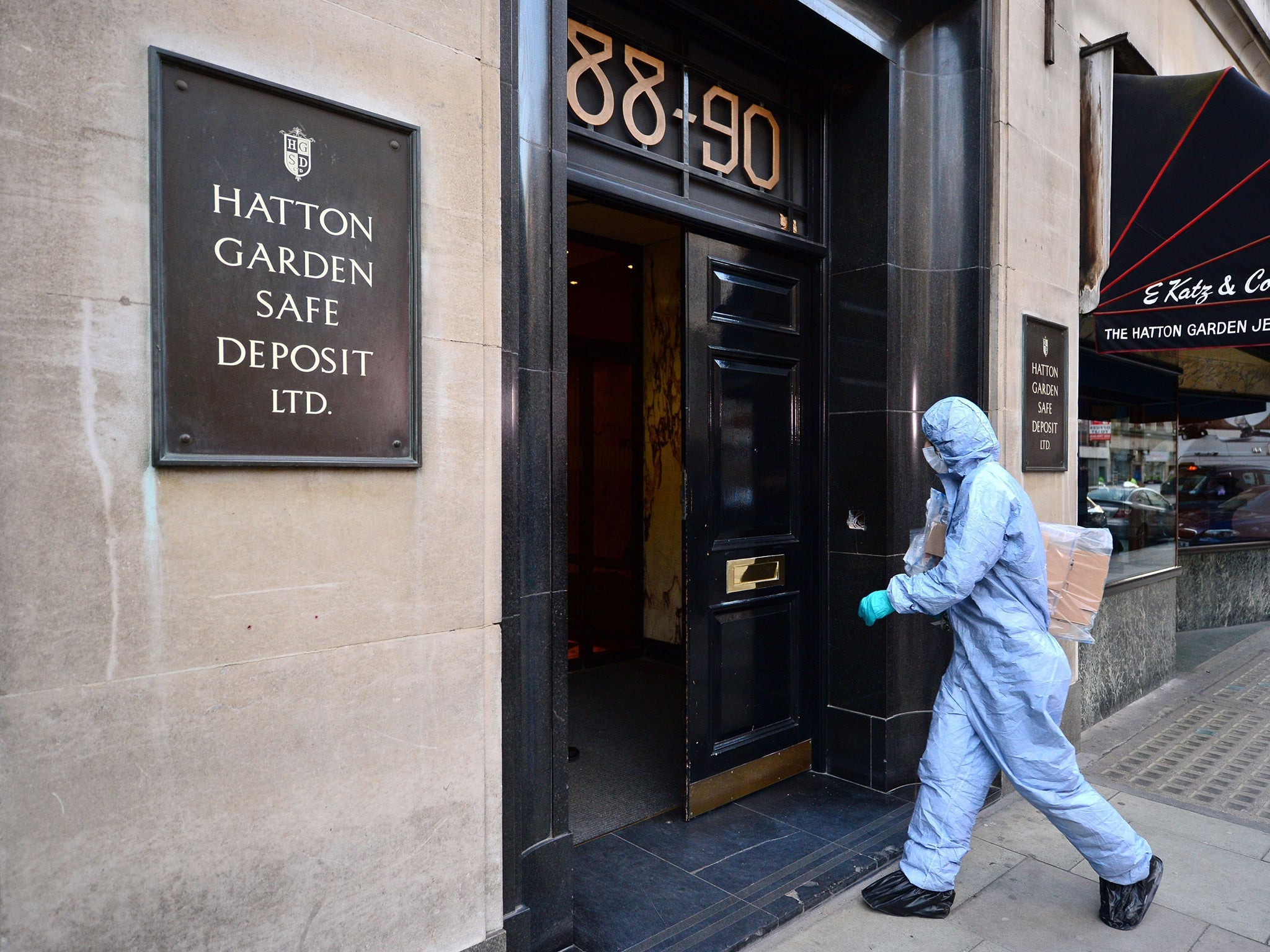Hatton Garden jewellery burglary: Gems still glitter in a digital world – and not just for thieves
The Hatton Garden theft seems like a crime of nostalgia. The sheer materiality of the deed and the loot belong to a disappearing world


Viewers with a taste for long-form Continental crime drama may remember Salamander. In this Belgian TV series, which occupied the slot that BBC4 likes to reserve for subtitled sleuths, thieves break into the vault of a dodgy private bank in Brussels and plunder 66 safe-deposit boxes. They turn out to contain the sexual and financial secrets of Belgium’s governing elite. Quaking in their designer boots, the toffs watch aghast as suicides and murders in the wake of the robbery pick off the nation’s establishment, one by one.
If only… The aftermath of the Easter weekend raid on the Hatton Garden Safe Deposit headquarters will be much less melodramatic. It might, indeed, prove almost invisible. Add to the omertà of the private-vault business the traditional confidentiality of the district’s jewellery trade and you have a recipe for silence, with losses of – often uninsured – treasures borne with firmly buttoned lips.
Into this void rushes speculative fantasy. The raid – inevitably overlaid with the Hollywood glamour of a “heist”, that prime example of media-only jargon never spoken by civilians – has already become what one its victims called “something out of a film”. First reports numbered the boxes emptied at 300; it was in fact more like 70. One retired detective plucked the figure of “£200m” in stolen deposits from thin air. That flaky guess set into a factoid, despite a later police estimate that values the losses closer to £35m.
Another superannuated plod weighed in with the fanciful idea that the villains had ignited an underground gas fire in nearby Holborn. There was never any evidence of that. And no sooner had reporters recited the details of the theft – complete with the “Hilti DD350 drill” which made short work of two metres of reinforced-concrete wall – than parallel plotlines from cinema muscled into the story: Sexy Beast, A Most Wanted Man, Casino, The Bourne Identity…
Not only did the Hatton Garden theft slip over the border from news to myth as swiftly as its proceeds have no doubt left the country. It rapidly acquired a branding as a crime of nostalgia, a felonious trip down memory lane marked by “old-fashioned audacity”. True, no one was hurt in the raid itself, although the kind of gang able to commit such an act might not think twice about despatching any foe or former friend who got in its way. More importantly, the sheer materiality of the deed and the loot seems to belong to a disappearing world. In an age of rampant cyber-fraud, such a “heist” returns the criminal underworld from pixellated colour to Ealing Studios black and white.
Like the money that it follows, big-ticket theft went virtual years ago. According to a Home Office study, 47,980 reports of “cyber-enabled fraud” were filed in the UK in 2012. The National Fraud Intelligence Bureau has calculated that, in this country, online thieves stole £670m in the year to September 2014. On a global scale, the internet security firm McAfee reckons the cost of cyber-crime at an annual £200bn. In the so-called “Carbanak” attack disclosed by the Moscow-based Kaspersky Lab, which investigated it, criminals infiltrate the computer networks of banks via “spear phishing”. Once inside, they take over payment-control systems and siphon huge sums from the institutions. That malware may already have made off with a billion dollars.
In the Carbanak era, the resort to power tools, concrete drills and even the dear old crowbar (also found in Hatton Garden) as criminal implements of choice feels positively quaint. Yet the raiders knew that the lure of gems and bullion as a safe haven has not yet evaporated into the digitised ether. True, many banks have shrunk or stopped their safe-deposit services. Their use may now strike regulators as suspicious as well as outdated. In 2008, a police investigation into deposit-box businesses in London found heroin and handguns stashed away along with Dutch Old Master paintings and £50m in cash.
Still, jewellery and gold continue to shine for plenty of honest folk. The strongbox habit has not quite gone extinct. Portable, tradable, convertible, easily hidden or given, gems have historically outwitted tyrants and patriarchs. Often passed from mother to daughter down the generations, diamonds – and their shiny sisters – may still be a girl’s best friend. In some Asian communities, their appeal has yet to fade. Safe-deposit use remains buoyant from Hounslow to Leicester. From Robespierre’s France and Lenin’s Russia to Hitler’s Germany and Idi Amin’s Uganda, communities at risk of expropriation and expulsion have had rock-solid reasons to invest in stones. Anyone who believes that “the rich” alone sink their assets into gems and metal knows little of the modern history of persecution and migration. Many Holocaust survivors tell of Nazis bribed and borders crossed thanks to the carefully secreted family jewels.
Insecurity, and vulnerability, have always shaped the trade in gems and helped to fill the ranks of those who run it. If many of Hatton Garden’s 300-odd jewellery-related business remain Jewish-owned, then Asian traders have long since begun to plant a foothold there. And the old neighbourhood, flung reluctantly into the spotlight, is lucky to have a gifted chronicler.
She is the social historian Rachel Lichtenstein, whose husband, parents, grandparents, aunts and uncles have all worked or work in the jewellery trade around Hatton Garden. In her wonderfully atmospheric book Diamond Street: the Hidden World of Hatton Garden, she remembers accompanying her dad when he went to buy pieces from there to sell on his Portobello stall; later, he managed a Hatton Garden store. A sacred handshake would seal the deal with the Yiddish words mazel und broche: luck and blessing. “It is,” Lichtenstein reports, still able to use the present tense, “a secret, private, hidden world” with “a strict set of unspoken internal laws”. This world has even survived the departure of diamond giant De Beers, which – after 125 years – quit London for Botswana in 2013. Via characters such as ring-maker Isadore Mitziman and dealer Dave Harris, Lichtenstein uncovers a code that valued “integrity, intelligence and industry”, because – as Harris tells her – “once you get a bad name in the street, you’re finished”.
In Antwerp, still the chief Continental hub of the diamond trade, an intriguing study by Kathryn Lum of the European University Institute in Florence has found that Indians are replacing Jews at the heart of the business. “As you look along the names on the office doors, what is striking are the names,” she writes. “Whereas a generation ago, the vast majority of them were Jewish, today, a significant majority are of Indian, and in particular, Gujarati origin. Names like Mehta and Patel are particularly common.” Although “the orthodox Jewish presence in Antwerp is still highly visible… a new generation of young and dynamic entrepreneurs from Gujarat have displaced them”.
In Gujarat itself, diamonds boom: the business employs an estimated 500,000 people across the state. The trade has made the diamond centre of Surat, by some measures, the richest city in all India. Business-friendly Prime Minister Narendra Modi has now approved feasibility studies for India’s first high-speed rail corridor. If built, it will connect Mumbai to Ahmedabad – via Surat. Far from fading into a vintage past, the concentrated riches packed into the sparklers are still able to sway national policy. Those rocks still dazzle.
Over the centuries, the iridescent wealth dismissed as “bling” by prosaic minds has not only decorated bodies but also stored patrimonies, protected families and even saved lives. For sensible as well as sentimental reasons, subterranean rooms still shelter compacted legacies in the form of rings and pendants, earrings and necklaces. Will the Hatton Garden “heist” dent the confidence of owners and dealers who favour tangible treasure over paper promises? That seems improbable. The fully automated financial catastrophe of 2008 – along with the cyber-fraud pandemic and long-term near-zero savings rates – has given traditionally minded investors firmer motives to place their faith in rocks. Those banks that plan to close their vaults may have chosen the wrong moment.
According to the World Diamond Council, global trade in the condensed carbon is worth in excess of $72bn – a three-fold increase over the past quarter-century. The council claims that, since the so-called Kimberley Process of certification came into force, gems no longer fund the civil wars of Africa and “more than 99 per cent of diamonds are from conflict-free zones”. Independent analysts, however, suspect that fake certificates obtained by bribery mask continuing commerce in “blood diamonds”.
Yet from polishers’ workshop in Surat to dealer in Hatton Garden, from Hong Kong auctioneer to high-street jeweller, the stones still seduce. If the top end of the market can serve as any guide, the future of gems glitters. On 21 April, Sotheby’s in New York will auction a 100-carat emerald-cut diamond described as “perfect” and “unlike any diamond offered at auction before”. It may fetch more than $25m. Such a price, however, sounds like small change compared with the world-record $83.2m bid in Geneva in November 2013 for the flawless “Pink Star” diamond, mined by De Beers in 1999. A rare default tarnished the fairy tale: the buyer failed to raise the cash. Sotheby’s still holds the super-precious stone. This week, one has to ask: in whose vault?
Join our commenting forum
Join thought-provoking conversations, follow other Independent readers and see their replies
Comments